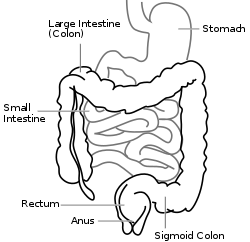Colon (anatomy)
| Large intestine | |
|---|---|

Front of abdomen, showing the large intestine, with the stomach and small intestine in gray outline.
|
|

Front of abdomen, showing surface markings for liver (red), and the stomach and large intestine (blue). The large Intestine is like an upside down U.
|
|
| Details | |
| Artery | Superior mesenteric, inferior mesenteric and iliac arteries |
| Vein | Superior and inferior mesenteric vein |
| Lymph | Inferior mesenteric lymph nodes |
| Identifiers | |
| Latin | Colon or intestinum crassum |
| TA | A05.7.01.001 |
| FMA | 7201 |
|
Anatomical terminology
[]
|
|
The large intestine, or the large bowel, is the last part of the gastrointestinal tract and of the digestive system in vertebrates. Water is absorbed here and the remaining waste material is stored as feces before being removed by defecation.
Most sources define the large intestine as the combination of the cecum, colon, rectum, and anal canal. Some other sources exclude the anal canal.
In humans, the large intestine begins in the right iliac region of the pelvis, just at or below the waist, where it is joined to the end of the small intestine at the cecum, via the ileocecal valve. It then continues as the colon ascending the abdomen, across the width of the abdominal cavity as the transverse colon, and then descending to the rectum and its endpoint at the anal canal. Overall, in humans, the large intestine is about 1.5 metres (5 ft) long, which is about one-fifth of the whole length of the gastrointestinal tract.
The colon is the last part of the digestive system. It extracts water and salt from solid wastes before they are eliminated from the body and is the site in which flora-aided (largely bacterial) fermentation of unabsorbed material occurs. Unlike the small intestine, the colon does not play a major role in absorption of foods and nutrients. About 1.5 litres or 45 ounces of water arrives in the colon each day.
...
Wikipedia
